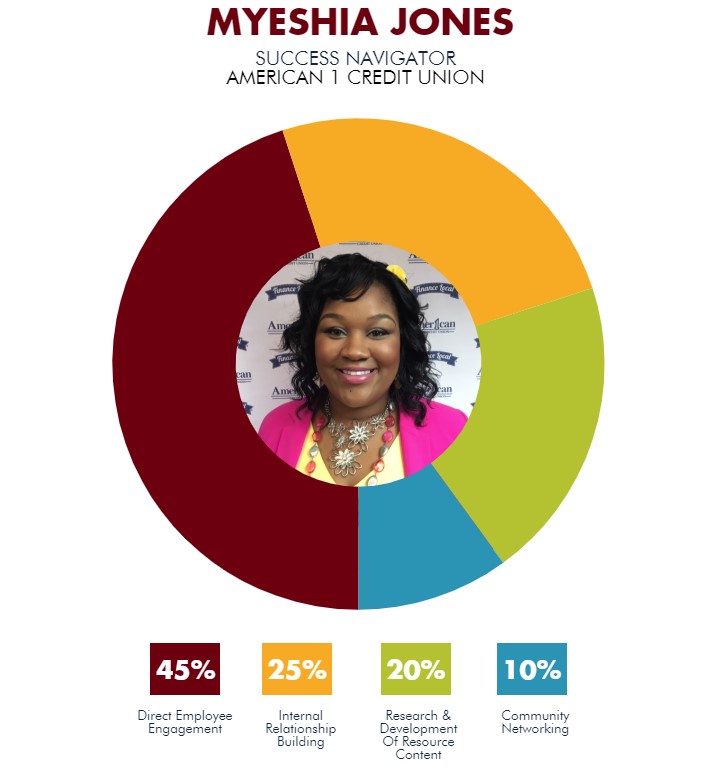American 1 Credit Union ($390.4M, Jackson, MI) faces the same issues as any other credit union when it comes to hiring and retaining good employees, but one of its solutions sticks out as particularly innovative.
The mid-Michigan credit union recently created the role of success navigator, someone who helps staff deal with personal issues outside the scope of traditional HR concerns but very real to someone dealing with family care, transportation, and other distractions to focusing on the job to be done at work.
Myeshia Jones is American 1’s first success navigator. Here, she explains what it’s all about.

How long have you been with American 1 and in the role of success navigator?
Myeshia Jones: I joined American 1 in October of 2018. I originally applied for a different position, but during my interview the human resources team learned about my strong community connections and passion for helping people improve their lives, and the discussion shifted to the success navigator position.
Why was the position created?
MJ: The success navigator position was created to connect team members with resources and training to help overcome barriers to successful employment and to increase retention. Employee turnover, especially at the entry level, is often related to obstacles that people need help to overcome. Barriers to workplace success might include family or medical challenges, child care, transportation, marital stress, lack of basic computer skills, financial stressors, etc.
Our HR team identified that sometimes people simply aren’t aware of resources that are available to help them. Our board chair, Philip E. Hoffman Jr., also serves on the board of Jackson College. Through Phil, our CEO, Martha Fuerstenau, became familiar with a program at the college that has effectively increased student retention and success. The position of success navigator was loosely modeled after that program.
Who do you report to and who reports to you?
MJ: The success navigator reports to the vice president of human resources. I do not have direct reports.
What made you a great fit for this job?
MJ: While I’ve worked at another financial institution and have an industry background, it’s my passion for helping people and my connections in the community that provided the opportunity to join the team as success navigator. I’m also finishing my MBA in strategic communication and leadership so my educational background is a plus. I’m highly involved as a volunteer with several non-profit organizations, too.
This position requires someone who is approachable and trustworthy as well as knowledgeable about community services. Often the problem that an employee brings to me is not the real problem. I have to be able to peel back the onion to get to the root cause and then recommend the appropriate solution based on each individual situation.
Job titles say as much about the organization as they do the person. The “What’s In A Name” series on CreditUnions.com dives into notable, important, interesting, or just plain fun roles to find out what’s happening at the ground level and across the industry. Browse the whole series only on CreditUnions.com.
What’s your daily routine?
MJ: My schedule is based around formal training and meetings with individual team members which may be initiated by the employee or requested by a manager. I create plans for team members to gain new skills or resolve obstacles to their success. I schedule follow-up communications with every employee who has an established growth plan to assess progress and provide accountability.
I’m also involved in onboarding new employees in the form of six-week and six-month check-ins. The purpose of the new employee check-in is to proactively identify potential opportunities for growth and development and address any issues before they impact productivity.
I visit our branches to build relationships with employees, which gives team members the opportunity to approach me in a more casual setting with questions or concerns.
What are your areas of responsibility?
MJ: My areas of responsibility are divided among employee success (providing access to resources that remove obstacles employees are facing); employee engagement (being present in every branch, interacting in their environment regularly to build trusting relationships); first job success (providing mentoring for employees who are new to the workforce, addressing appropriate dress, soft skill training, professional behavior, and more); co-op students and college interns (mentoring and monitoring high school and college students on our team).
How do you track success in your job?
MJ: To the extent possible, we’re tracking successes by documenting the issues the success navigator is providing resources for, as well as the employee engagement with those resources.
There’s also a formal process for employee and manager feedback which provides information about employee improvement or the resolution of obstacles to success.
We’ll measure retention; however, at this time, it’s too early to directly attribute a reduction in turnover to the position of success navigator.
How do you stay current with topics that fall under your role?
MJ: My role requires that I remain informed about relevant topics such as community and state resources, social issues, diversity and inclusion, and employee engagement. I attend seminars that make me aware of resources and keep me up to date on the topics that will best help me help our team members be successful.
This interview has been edited and condensed.